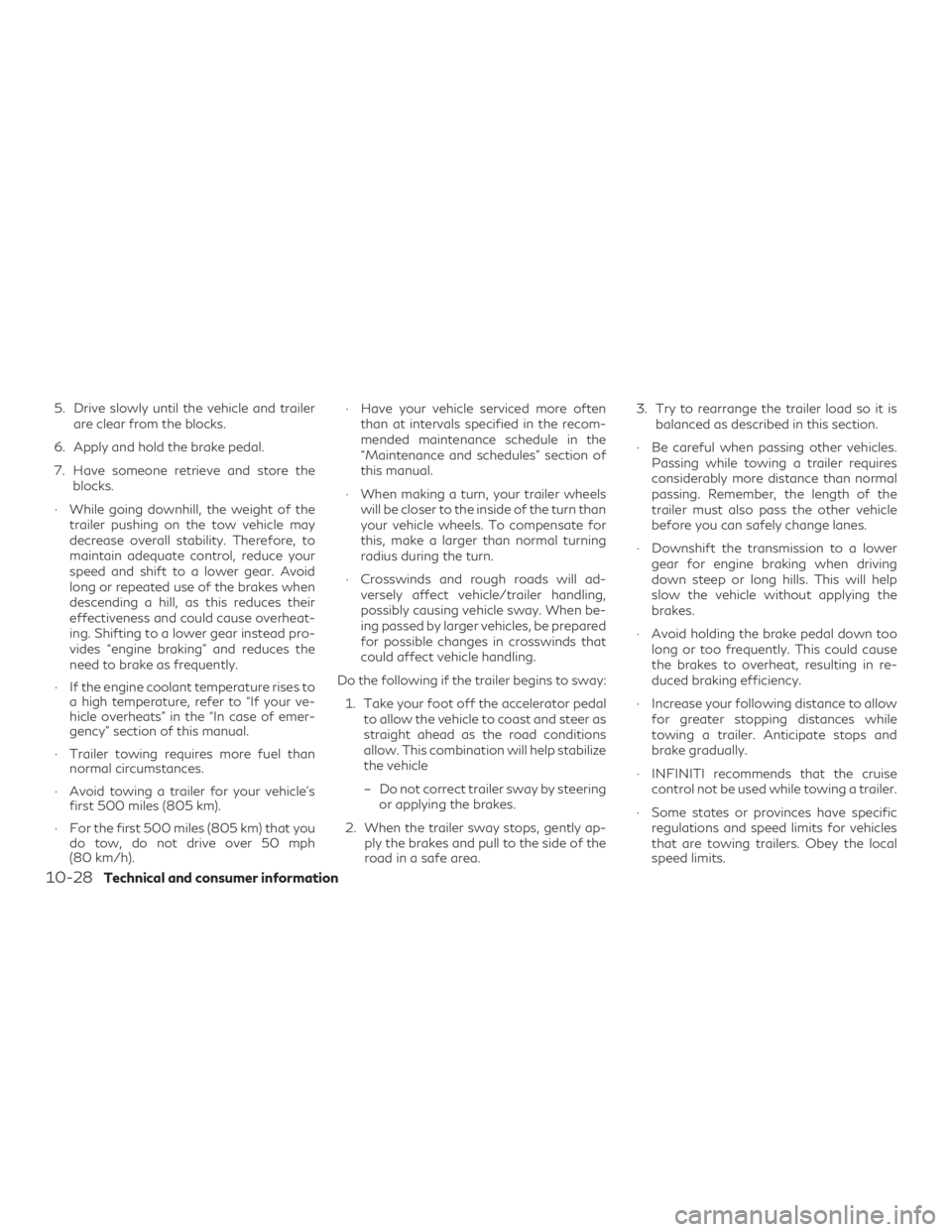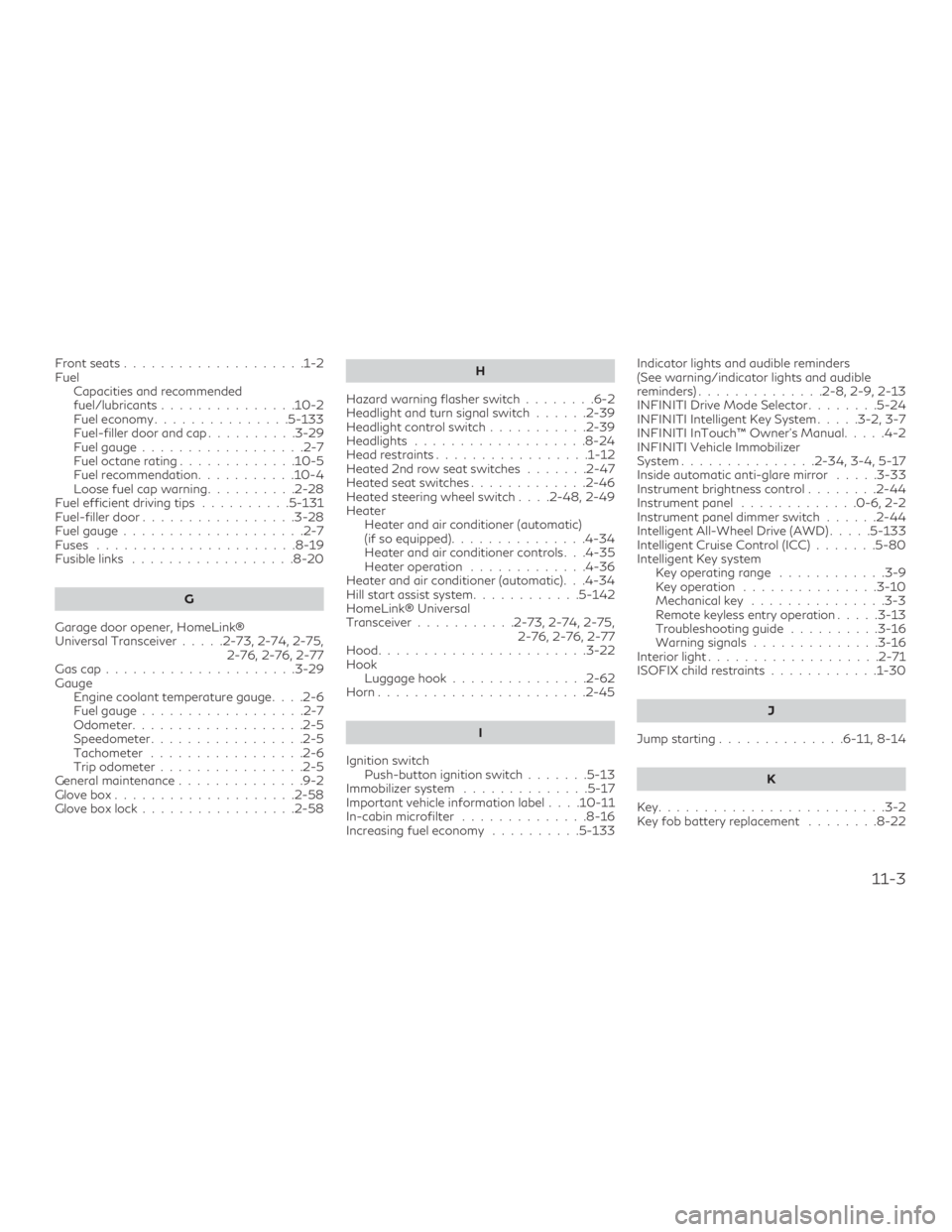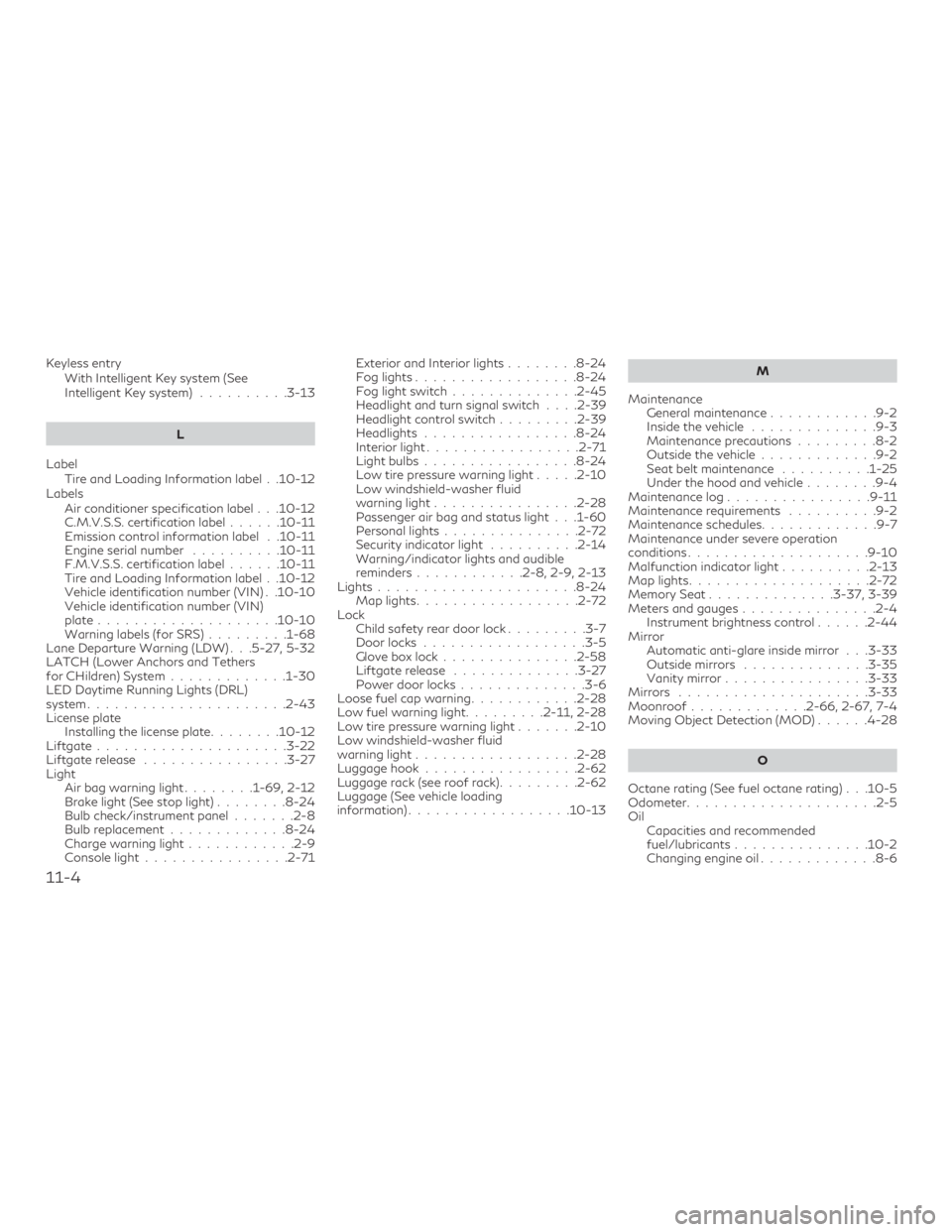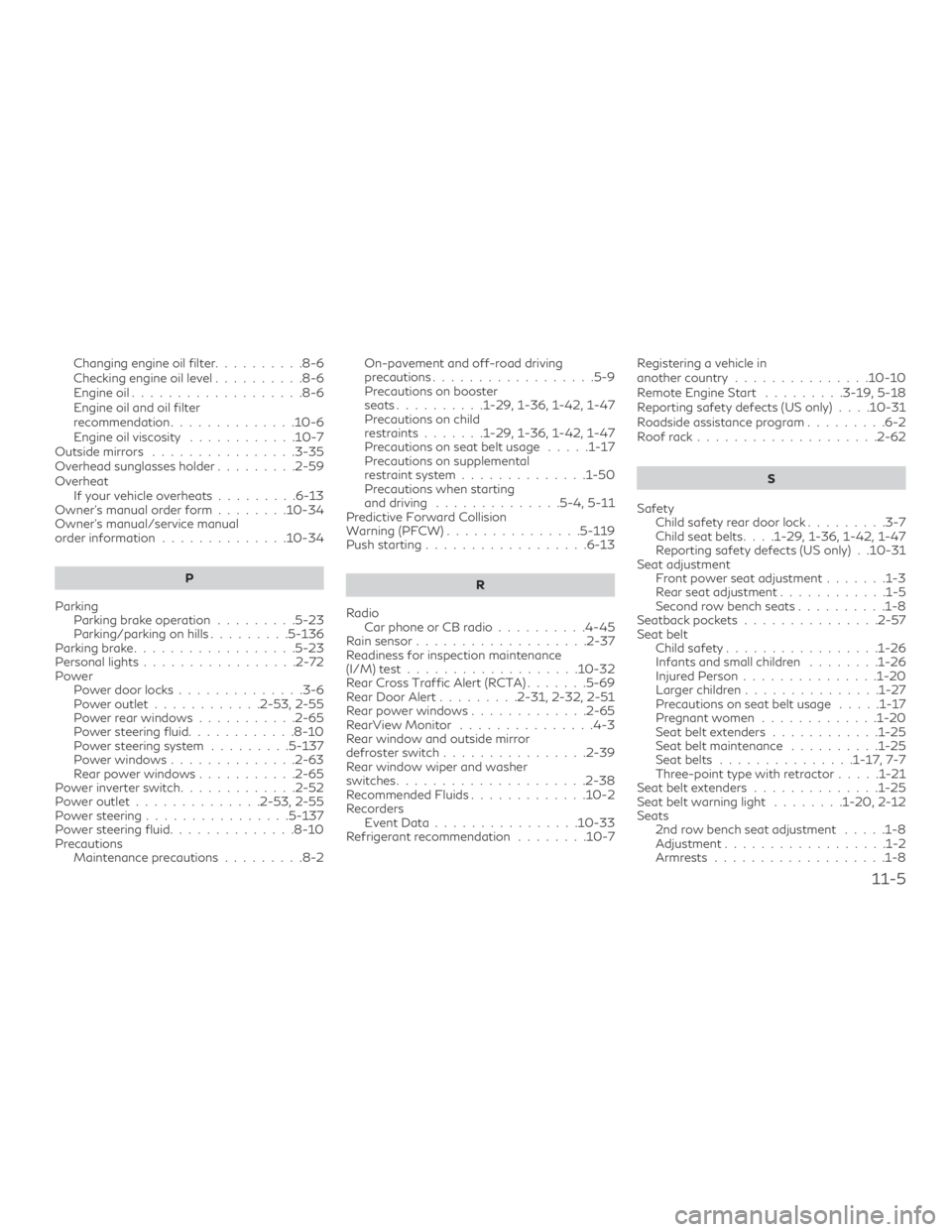engine INFINITI QX60 2020 Owner's Manual
[x] Cancel search | Manufacturer: INFINITI, Model Year: 2020, Model line: QX60, Model: INFINITI QX60 2020Pages: 538, PDF Size: 6.19 MB
Page 507 of 538

LOADING TIPS
∙ The GVW must not exceed GVWRor GAWR as specified on the
F.M.V.S.S./C.M.V.S.S. certifica-
tion label.
∙ Do not load the front and rear axle to the GAWR. Doing so will exceed
the GVWR.
WARNING
∙ Properly secure all cargo with ropes or straps to help prevent it
from sliding or shifting. Do not
place cargo higher than the seat-
backs. In a sudden stop or collision,
unsecured cargo could cause per-
sonal injury.
∙ Do not load your vehicle any heavier than the GVWR or the
maximum front and rear GAWRs.
If you do, parts of your vehicle can
break, tire damage could occur, or
it can change the way your vehicle
handles. This could result in loss of
control and cause personal injury. ∙ Overloading not only can shorten
the life of your vehicle and the tire,
but can also cause unsafe vehicle
handling and longer braking dis-
tances. This may cause a prema-
ture tire failure which could result
in a serious accident and personal
injury. Failures caused by over-
loading are not covered by the ve-
hicle’s warranty.MEASUREMENT OF WEIGHTS
Secure loose items to prevent weight
shifts that could affect the balance of
your vehicle. When the vehicle is
loaded, drive to a scale and weigh the
front and the rear wheels separately
to determine axle loads. Individual axle
loads should not exceed either of the
gross axle weight ratings (GAWR). The
total of the axle loads should not ex-
ceed the gross vehicle weight rating
(GVWR). These ratings are given on
the vehicle certification label. If weight
ratings are exceeded, move or remove
items to bring all weights below the
ratings.
WARNING
Overloading or improper loading of a trailer
and its cargo can adversely affect vehicle
handling, braking and performance and
may lead to accidents.
CAUTION
∙ Do not tow a trailer or haul a heavy load
for the first 500 miles (805 km). Your
engine, axle or other parts could be
damaged.
∙ For the first 500 miles (805 km) that you tow a trailer, do not drive over 50 mph
(80 km/h) and do not make starts at full
throttle. This helps the engine and other
parts of your vehicle wear in at the
heavier loads.
NOTE:
Tow hitches are available as an accessory for
this vehicle. If a tow hitch is installed, the
liftgate electronic control unit (ECU) needs
to be replaced with an ECU programmed
with towing logic for the Motion-Activated
Liftgate to function properly.
TOWING A TRAILER
Technical and consumer information10-17
Page 508 of 538

Your new vehicle was designed to be used
primarily to carry passengers and cargo. Re-
member that towing a trailer places addi-
tional loads on your vehicle’s engine, drive
train, steering, braking and other systems.
An INFINITI Towing Guide (U.S. only) is avail-
able on the website atwww.InfinitiUSA.com.
This guide includes information on trailer
towing capability and the special equipment
required for proper towing.
MAXIMUM LOAD LIMITS
Maximum trailer loads
Never allow the total trailer load to exceed
the value specified in the following Towing
Load/Specification Chart found in this sec-
tion. The total trailer load equals trailer
weight plus its cargo weight.
∙ When towing a trailer load of 3,500 lbs.
(1,587 kg) or more, trailers with a brake
system MUST be used.
The maximum Gross Combined Weight Rat-
ing (GCWR) should not exceed the value
specified in the following Towing
Load/Specification Chart. The GCWR equals the combined weight of
the towing vehicle (including passengers and
cargo) plus the total trailer load. Towing
loads greater than these or using improper
towing equipment could adversely affect ve-
hicle handling, braking and performance.
The ability of your vehicle to tow a trailer is
not only related to the maximum trailer loads,
but also the places you plan to tow. Tow
weights appropriate for level highway driving
may have to be reduced for low traction situ-
ations (for example, on slippery boat ramps).
Temperature conditions can also affect tow-
ing. For example, towing a heavy trailer in
high outside temperatures on graded roadscan affect engine performance and cause
overheating. The engine protection mode,
which helps reduce the chance of engine
damage, could activate and automatically
decrease engine power. Vehicle speed may
decrease under high load. Plan your trip care-
fully to account for trailer and vehicle load,
weather and road conditions.
WARNING
Overheating can result in reduced engine
power and vehicle speed. The reduced
speed may be lower than other traffic,
which could increase the chance of a colli-
sion. Be especially careful when driving. If
the vehicle cannot maintain a safe driving
speed, pull to the side of the road in a safe
area. Allow the engine to cool and return to
normal operation. For additional informa-
tion, refer to “If your vehicle overheats” in
the “In case of emergency” section of this
manual.
CAUTION
Vehicle damage resulting from improper
towing procedures is not covered by
INFINITI warranties.
LTI2030
10-18Technical and consumer information
Page 517 of 538

∙ Always secure items in the trailer to pre-vent load shift while driving.
∙ Keep the cargo load as low as possible in the trailer to keep the trailer center of
gravity low.
∙ Load the trailer so approximately 60% of the trailer load is in the front half and
40% is in the back half. Also make sure
the load is balanced side to side.
∙ Check your hitch, trailer tire pressure, ve- hicle tire pressure, trailer light operation,
and trailer wheel lug nuts every time you
attach a trailer to the vehicle.
∙ Be certain your rearview mirrors conform to all federal, state or local regulations. If
not, install any mirrors required for tow-
ing before driving the vehicle.
∙ Determine the overall height of the ve- hicle and trailer so the required clearance
is known.Trailer towing tips
In order to gain skill and an understanding of
the vehicle’s behavior, you should practice
turning, stopping and backing up in an area
which is free from traffic. Steering stability
and braking performance will be somewhat
different than under normal driving condi-
tions.
∙ Always secure items in the trailer to pre- vent load shift while driving.
∙ Lock the trailer hitch coupler with a pin or lock to prevent the coupler from inadver-
tently becoming unlatched.
∙ Avoid abrupt starts, acceleration or stops.
∙ Avoid sharp turns or lane changes.
∙ Always drive your vehicle at a moderate speed.
∙ When backing up, hold the bottom of the steering wheel with one hand. Move your
hand in the direction in which you want
the trailer to go. Make small corrections
and back up slowly. If possible, have
someone guide you when you are back-
ing up. Always block the wheels on both vehicle and
trailer when parking. Parking on a slope is not
recommended; however, if you must do so:
CAUTION
If you move the shift selector to the P
(Park) position before blocking the wheels
and applying the parking brake, transmis-
sion damage could occur.
1. Apply and hold the brake pedal.
2. Have someone place blocks on the downhill side of the vehicle and trailer
wheels.
3. After the wheel blocks are in place, slowly release the brake pedal until the
blocks absorb the vehicle load.
4. Apply the parking brake.
5. Shift the transmission into P (Park).
6. Turn off the engine.
To drive away: 1. Start the vehicle.
2. Apply and hold the brake pedal.
3. Shift the transmission into gear.
4. Release the parking brake.
Technical and consumer information10-27
Page 518 of 538

5. Drive slowly until the vehicle and trailerare clear from the blocks.
6. Apply and hold the brake pedal.
7. Have someone retrieve and store the blocks.
∙ While going downhill, the weight of the trailer pushing on the tow vehicle may
decrease overall stability. Therefore, to
maintain adequate control, reduce your
speed and shift to a lower gear. Avoid
long or repeated use of the brakes when
descending a hill, as this reduces their
effectiveness and could cause overheat-
ing. Shifting to a lower gear instead pro-
vides “engine braking” and reduces the
need to brake as frequently.
∙ If the engine coolant temperature rises to a high temperature, refer to “If your ve-
hicle overheats” in the “In case of emer-
gency” section of this manual.
∙ Trailer towing requires more fuel than normal circumstances.
∙ Avoid towing a trailer for your vehicle’s first 500 miles (805 km).
∙ For the first 500 miles (805 km) that you do tow, do not drive over 50 mph
(80 km/h). ∙ Have your vehicle serviced more often
than at intervals specified in the recom-
mended maintenance schedule in the
“Maintenance and schedules” section of
this manual.
∙ When making a turn, your trailer wheels will be closer to the inside of the turn than
your vehicle wheels. To compensate for
this, make a larger than normal turning
radius during the turn.
∙ Crosswinds and rough roads will ad- versely affect vehicle/trailer handling,
possibly causing vehicle sway. When be-
ing passed by larger vehicles, be prepared
for possible changes in crosswinds that
could affect vehicle handling.
Do the following if the trailer begins to sway: 1. Take your foot off the accelerator pedal to allow the vehicle to coast and steer as
straight ahead as the road conditions
allow. This combination will help stabilize
the vehicle
– Do not correct trailer sway by steering or applying the brakes.
2. When the trailer sway stops, gently ap- ply the brakes and pull to the side of the
road in a safe area. 3. Try to rearrange the trailer load so it is
balanced as described in this section.
∙ Be careful when passing other vehicles. Passing while towing a trailer requires
considerably more distance than normal
passing. Remember, the length of the
trailer must also pass the other vehicle
before you can safely change lanes.
∙ Downshift the transmission to a lower gear for engine braking when driving
down steep or long hills. This will help
slow the vehicle without applying the
brakes.
∙ Avoid holding the brake pedal down too long or too frequently. This could cause
the brakes to overheat, resulting in re-
duced braking efficiency.
∙ Increase your following distance to allow for greater stopping distances while
towing a trailer. Anticipate stops and
brake gradually.
∙ INFINITI recommends that the cruise control not be used while towing a trailer.
∙ Some states or provinces have specific regulations and speed limits for vehicles
that are towing trailers. Obey the local
speed limits.
10-28Technical and consumer information
Page 523 of 538

If a powertrain system component is repaired
or the battery is disconnected, the vehicle
may be reset to a “not ready” condition. Be-
fore taking the I/M test, check the vehicle’s
inspection/maintenance test readiness con-
dition. Place the ignition switch in the ON
position without starting the engine. If the
Malfunction Indicator Light (MIL) comes on
steady for 20 seconds and then blinks for
10 seconds , the I/M test condition is “not
ready”. If the MIL does not blink after 20 sec-
onds, the I/M test condition is “ready”. It is
recommended that you visit an INFINITI re-
tailer to set the “ready condition” or to pre-
pare the vehicle for testing.This vehicle is equipped with an EDR. The
main purpose of an EDR is to record, in cer-
tain collision or near collision-like situations,
such as an air bag deployment or hitting a
road obstacle, data that will assist in under-
standing how a vehicle’s systems performed.
The EDR is designed to record data related to
vehicle dynamics and safety systems for a
short period of time, typically 30 seconds or
less. The EDR in this vehicle is designed to
record such data as:
∙ How various systems in your vehicle were operating;
∙ Whether or not the driver and passenger safety belts were buckled/fastened;
∙ How far (if at all) the driver was depress- ing the accelerator and/or brake pedal;
and,
∙ How fast the vehicle was traveling.
∙ Sounds are not recorded. These data can help provide a better under-
standing of the circumstances in which colli-
sions and injuries occur. NOTE: EDR data are
recorded by your vehicle only if a nontrivial
collision situation occurs; no data are re-
corded by the EDR under normal driving con-
ditions and no personal data (e.g. name, gen-
der, age and collision location) are recorded.
However, other parties, such as law enforce-
ment, could combine the EDR data with the
type of personally identifying data routinely
acquired during a collision investigation.
To read data recorded by an EDR, special
equipment is required and access to the ve-
hicle or the EDR is needed. In addition to the
vehicle manufacturer and INFINITI retailer,
other parties, such as law enforcement, that
have the special equipment, can read the in-
formation if they have access to the vehicle or
the EDR. EDR data will only be accessed with
the consent of the vehicle owner or lessee or
as otherwise required or permitted by law.
EVENT DATA RECORDERS (EDR)
Technical and consumer information10-33
Page 525 of 538

11 Index
2nd row bench seat adjustment.......1-8
A
Air bag (See supplemental restraint
system).....................1-50
Air bag system Front (See supplemental front impact
airbagsystem) ..............1-57
Air bag warning labels ............1-68
Airbagwarninglight.........1-69,2-12
Air bag warning light,
supplemental ..............1-69,2-12
Air cleaner ...................8-16
Air cleaner housing filter ...........8-16
Air conditioner Air conditioner operation ........4-35
Air conditioner specification label . .10-12
Air conditioner system refrigerant
and oil recommendations ........10-7
Heater and air conditioner (automatic)
(if so equipped) ..............4-34
Heater and air conditioner controls . .4-35
Servicing air conditioner .........4-44
Alarm system (See vehicle
security system) ................2-32
Anchor point locations ............1-33
Antenna ....................4-45
Antifreeze ..................5-147
Anti-lock brake warning light .........2-9
Anti-lock Braking System (ABS) .....5-138
Armrests.....................1-8 Around View® Monitor
...........4-11
Audible reminders ...............2-15
Autolight switch ...............2-40
Automatic Automatic drive positioner . . .3-37, 3-39
Automatic power window switch . . .2-65
Automatic anti-glare inside mirror .....3-33
Automatic door locks .............3-6
Automatic drive positioner .....3-37,3-39
B
Backup Collision Intervention (BCI) ....5-60
Battery ................5- 147, 8-13
Charge warning light ...........2-9
Battery replacement .............8-22
INFINITI Intelligent Key .........8-22
Keyfob...................8-22
Before starting the engine ..........5-17
Belt (See drive belt) ..............8-15
Blind Spot Intervention® (BSI) .......5-48
Blind Spot Warning (BSW) .........5-38
Boosterseats.................1-47
Brake Anti-lock Braking System (ABS) . . .5-138
Brakefluid.................8-11
Brakelight(Seestoplight) .......8-24
Brake system ..............5-138
Brakewarninglight ............2-9
Brakewearindicators ......2-15,8-19
Parking brake operation .........5-23
Self-adjusting brakes ..........8-19 Brake Assist
.................5-139
Brakefluid...................8-11
Brakes .....................8-19
Brake system ................5-138
Break-in schedule ..............5-131
Brightness control Instrument panel .............2-44
Bulb check/instrument panel .........2-8
Bulb replacement ............... 8-24
C
Camera Aiding Sonar (parking sensor) . .4-24
Capacities and recommended fuel/
lubricants ...................10-2
Cargoareastoragebin ...........2-61
Cargolight...................2-72
Cargo (See vehicle loading
information).................10-13
Car phone or CB radio ............4-45
Check tire pressure ..............2-28
Child restraints .....1-26,1-26,1 -28, 1-30
LATCH (Lower
Anchors and Tethers
for CHildren) System ...........1-30
Precautions on child
restraints .......1-29,1-36,1 -42, 1-47
Top tether strap anchor point
locations..................1-33
Child restraint with top tether strap . . . .1-33
Child safety rear door lock ..........3-7
Chimes, audible reminders ..........2-15
Cleaning exterior and interior ......7-2, 7-4
Page 526 of 538

Climate control seat switch.........2-45
C.M.V.S.S. certification label ........10-11
Cold weather driving .............5-147
Console box ..................2-58
Console light ..................2-71
Continuously Variable Transmission
(CVT) .......................5-19
Continuously Variable Transmission
(CVT) fluid .................8-10
Driving with Continuously Variable
Transmission (CVT) ............5-19
Controls Heater and air conditioner controls . . .4-35
Coolant Capacities and recommended
fuel/lubricants...............10-2
Changing engine coolant ..........8-5
Checking engine coolant level .......8-5
Engine coolant temperature gauge ....2-6
Corrosion protection ..............7-7
Cruisecontrol..............5-78,5-79
Cupholders...................2-60
D
Defroster switch Rear window and outside mirror
defroster switch ..............2-39
Dimensionsandweights...........10-9
Dimmer switch for instrument panel ....2-44
Distance Control Assist (DCA) .......5-100
Door locks ....................3-5
Drivebelt....................8-15
Drive positioner, Automatic .....3-37,3-39Driving
Cold weather driving ...........5-147
Driving with Continuously Variable
Transmission (CVT) ............5-19
Precautions when starting
and driving ..............5-4,5-11
Driving the vehicle ...............5-19
Dual panel moonroof .............2-67
Dual power moonroof ............2-67
E
E-call (SOS) Button ..............2-53
Economy - fuel ................5-133
Emergency engine shutoff .......5-16,6-3
Emission control information label ....10-11
Emission control system warranty ....10-31
Engine Before starting the engine ........5-17
Block heater ................5-149
Capacities and recommended
fuel/lubricants...............10-2
Changing engine coolant ..........8-5
Changing engine oil .............8-6
Changing engine oil filter ..........8-6
Checking engine coolant level .......8-5
Checking engine oil level ..........8-6
Engine compartment check locations . .8-3
Engine coolant temperature gauge ....2-6
Engine cooling system ...........8-4
Engine oil ...................8-6
Engine oil and oil filter
recommendation ..............10-6
Engine oil viscosity ............10-7
Engine serial number ..........10-11 Engine specifications
...........10-8
Starting the engine ............5-17
Engine coolant temperature gauge ......2-6
Event Data recorders ............10-33
Exhaust gas (Carbon monoxide) .......5-4
Explanation of maintenance items ......
9
-2
Explanation of scheduled maintenance
items........................9-5
Extended storage switch ...........2-55
F
Flashers (See hazard warning flasher
switch) ......................6-2
Flat tire ......................6-3
Floor mat positioning aid ............7-5
Fluid Brakefluid..................8-11
Capacities and recommended
fuel/lubricants............... 10-2
Continuously Variable Transmission
(CVT) fluid .................8-10
Engine coolant ................8-4
Engine oil ...................8-6
Power steering fluid ............8-10
Windshield-washerfluid.........8-11
F.M.V.S.S. certification label ........10-11
Fog light switch ................ 2-45
Forward Emergency Braking (FEB) with
Pedestrian Detection system ....2-10,5-111
Front air bag system (See
supplemental restraint system) .......1-57
Front and rear sonar system ........5-144
Front-door pocket ...............2-56
Front power seat adjustment .........1-3
11-2
Page 527 of 538

Frontseats....................1-2
FuelCapacities and recommended
fuel/lubricants...............10-2
Fuel economy ...............5-133
Fuel-filler door and cap ..........3-29
Fuel gauge ..................2-7
Fueloctanerating.............10-5
Fuel recommendation ...........10-4
Loose fuel cap warning ..........2-28
Fuel efficient driving tips ..........5-131
Fuel-filler door .................3-28
Fuel gauge ....................2-7
Fuses ......................8-19
Fusiblelinks ..................8-20
G
Garage door opener, HomeLink®
UniversalTransceiver.....2-73,2-74,2-75, 2-76, 2-76, 2-77
Gascap.....................3-29
Gauge Engine coolant temperature gauge ....2-6
Fuel gauge ..................2-7
Odometer ...................2-5
Speedometer .................2-5
Tachometer .................2-6
Trip odometer ................2-5
General maintenance ..............9-2
Glovebox....................2-58
Gloveboxlock.................2-58 H
Hazard warning flasher switch ........6-2
Headlight and turn signal switch ......2-39
Headlight control switch ...........2-39
Headlights ...................8-24
Head restraints .................1-12
Heated 2nd row seat switches .......2-47
Heated seat switches .............2-46
Heated steering wheel switch ....2-48,2-49
Heater Heater and air conditioner (automatic)
(if so equipped) ...............4-34
Heater and air conditioner controls . . .4-35
Heater operation .............4-36
Heater and air conditioner (automatic). . .4-34
Hill start assist system ............5-142
HomeLink® Universal
Transceiver...........2-73,2-74,2-75, 2-76, 2-76, 2-77
Hood .......................3-22
Hook Luggage hook ...............2-62
Horn.......................2-45
I
Ignition switch Push-button ignition switch .......5-13
Immobilizer system ..............5-17
Important vehicle information label ....10-11
In-cabin microfilter ..............8-16
Increasing fuel economy ..........5-133Indicator lights and audible reminders
(See warning/indicator lights and audible
reminders)
..............2-8,2-9,2-13
INFINITI Drive Mode Selector ........5-24
INFINITI Intelligent Key System .....3-2, 3-7
INFINITI InTouch™ Owner's Manual .....4-2
INFINITI Vehicle Immobilizer
System ...............2-34,3-4,5-17
Inside automatic anti-glare mirror .....3-33
Instrument brightness control ........2-44
Instrument panel .............0-6,2-2
Instrument panel
dimmer switch ......2-44
Intelligent All-Wheel Drive (AWD) .....5-133
Intelligent Cruise Control (ICC) .......5-80
Intelligent Key system Key operating range ............3-9
Keyoperation ...............3-10
Mechanical key ...............3-3
Remote keyless entry operation .....3-13
Troubleshooting guide ..........3-16
Warningsignals ..............3-16
Interiorlight...................2-71
ISOFIX child restraints ............1-30
J
Jump starting ..............6-11, 8-14
K
Key.........................3-2
Key fob battery replacement ........8-22
11-3
Page 528 of 538

Keyless entryWith Intelligent Key system (See
Intelligent Key system) ..........3-13
L
Label Tire and Loading Information label . .10-12
Labels Air conditioner specification label . . .10-12
C.M.V.S.S. certification label ......10-11
Emission control information label . .10-11
Engine serial number ..........10-11
F.M.V.S.S. certification label ......10-11
Tire and Loading Information label . .10-12
Vehicle identification number (VIN) . .10-10
Vehicle identification number (VIN)
plate....................10-10
Warning labels (for SRS) .........1-68
Lane Departure Warning (LDW) . . .5-27, 5-32
LATCH (Lower Anchors and Tethers
forCHildren)System.............1-30
LED Daytime Running Lights (DRL)
system......................2-43
License plate Installing the license plate ........10-12
Liftgate.....................3-22
Liftgaterelease ................3-27
Light Airbagwarninglight........1-69,2-12
Brakelight(Seestoplight)........8-24
Bulb check/instrument panel .......2-8
Bulb replacement .............8-24
Charge warning light ............2-9
Console light ................2-71 ExteriorandInteriorlights........8-24
Foglights..................8-24
Fog light switch
..............2-45
Headlight and turn signal switch ....2-39
Headlight control switch .........2-39
Headlights .................8-24
Interiorlight.................2-71
Lightbulbs.................8-24
Low tire pressure warning light .....2-10
Low windshield-washer fluid
warninglight................2-28
Passenger air bag and status light . . .1-60
Personal lights ...............2-72
Security indicator light ..........2-14
Warning/indicator lights and audible
reminders ............2-8,2-9,2-13
Lights......................8-24 Maplights..................2-72
Lock Child safety rear door lock .........3-7
Door locks ..................3-5
Gloveboxlock...............2-58
Liftgaterelease ..............3-27
Power door locks ..............3-6
Loose fuel cap warning ............2-28
Lowfuelwarninglight.........2-11,2-28
Low tire pressure warning light .......2-10
Low windshield-washer fluid
warninglight..................2-28
Luggage hook .................2-62
Luggage rack (see roof rack) .........2-62
Luggage (See vehicle loading
information)..................10-13 M
Maintenance Generalmaintenance............9-2
Inside the vehicle ..............9-3
Maintenance precautions .........8-2
Outside the vehicle .............9-2
Seat belt maintenance ..........1-25
Under the hood and vehicle ........9-4
Maintenance log ................9-11
Maintenance requirements ..........9-2
Maintenance schedules .............9-7
Maintenance under severe operation
conditions....................9-10
Malfunctionindicatorlight..........2-13
Maplights.................... 2-72
Memory Seat ..............3-37,3-39
Meters and gauges ...............2-4
Instrument brightness control ......2-44
Mirror Automatic anti-glare inside mirror . . .3-33
Outside mirrors .............. 3-35
Vanity mirror ................3-33
Mirrors .....................3-33
Moonroof .............2-66, 2-67, 7-4
Moving Object Detection (MOD) ......
4
-28
O
Octane rating (See fuel octane rating) . . .10-5
Odometer .....................2-5
Oil Capacities and recommended
fuel/lubricants............... 10-2
Changing engine oil .............8-6
11-4
Page 529 of 538

Changing engine oil filter..........8-6
Checking engine oil level ..........8-6
Engine oil ...................8-6
Engine oil and oil filter
recommendation ..............10-6
Engine oil viscosity ............10-7
Outside mirrors ................3-35
Overhead sunglasses holder .........2-59
Overheat If your vehicle overheats .........6-13
Owner's manual order form ........10-34
Owner's manual/service manual
orderinformation..............10-34
P
Parking Parking brake operation .........5-23
Parking/parking on hills .........5-136
Parkingbrake..................5-23
Personal lights .................2-72
Power Power door locks ..............3-6
Power outlet ............2-53,2-55
Power rear windows ...........2-65
Power steering fluid ............8-10
Power steering system .........5-137
Power windows ..............2-63
Rear power windows ...........2-65
Power inverter switch .............2-52
Power outlet ..............2-53,2-55
Power steering ................5-137
Power steering fluid ..............8-10
Precautions Maintenance precautions .........8-2On-pavement and off-road driving
precautions
..................5-9
Precautions on booster
seats..........1-29,1-36,1-42,1-47
Precautions on child
restraints .......1-29,1-36,1-42,1-47
Precautionsonseatbeltusage .....1-17
Precautions on supplemental
restraint system ..............1-50
Precautions when starting
and driving ..............5-4,5-11
Predictive Forward Collision
Warning(PFCW)...............5-119
Push starting ..................6-13
R
Radio Car phone or CB radio ..........4-45
Rainsensor...................2-37
Readiness for inspection maintenance
(I/M)test...................10-32
Rear Cross Traffic Alert (RCTA) .......5-69
Rear Door Alert .........2-31,2-32,2-51
Rear power windows .............2-65
RearView Monitor ...............4-3
Rear window and outside mirror
defroster switch ................2-39
Rear window wiper and washer
switches .....................2-38
Recommended Fluids .............10-2
Recorders Event Data ................10-33
Refrigerant recommendation ........10-7Registering a vehicle in
anothercountry...............10-10
Remote Engine Start
.........3-19,5-18
Reporting safety defects (US only) ....10-31
Roadside assistance program .........6-2
Roof rack ....................2-62
S
Safety Child safety rear door lock .........3-7
C h
ildseatbelts....1-29,1-36, 1-42, 1-47
Reporting safety defects (US only) . .10-31
Seat adjustment Front power seat adjustment .......1-3
Rear seat adjustment ............1-5
Second row bench seats ..........1-8
Seatback pockets ............... 2-57
Seat belt Childsafety.................1-26
Infantsandsmallchildren ........1-26
Injured Person ...............1-20
Largerchildren...............1-27
Precautionsonseatbeltusage .....1-17
Pregnant women .............1-20
Seat belt extenders ............1-25
Seat belt maintenance ..........1-25
Seat belts ...............1 -17, 7-7
Three-point type with retractor .....1-21
Seat belt extenders ..............1-25
Seat belt warning light ........1-20,2-12
Seats 2nd row bench seat adjustment .....1-8
Adjustment ..................1-2
Armrests ...................1-8
11-5